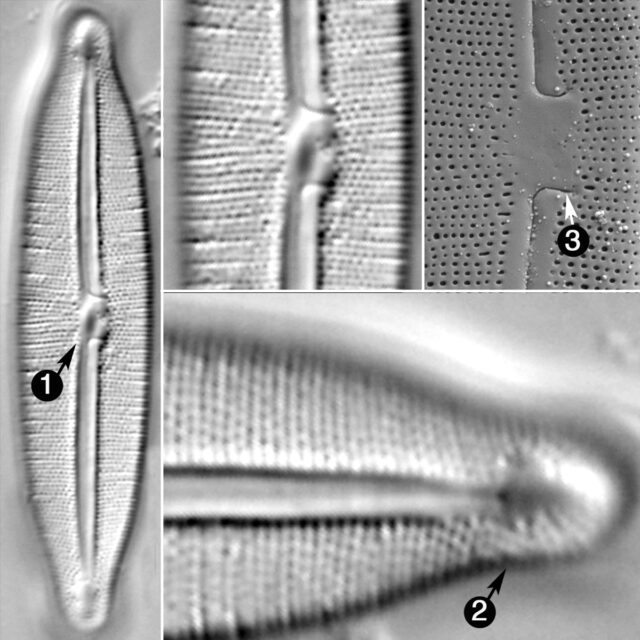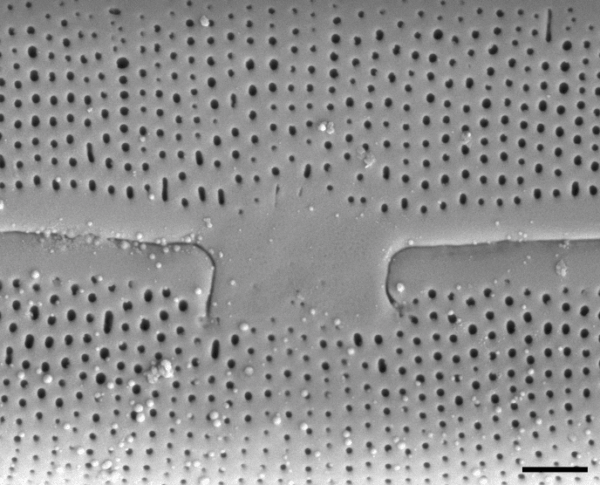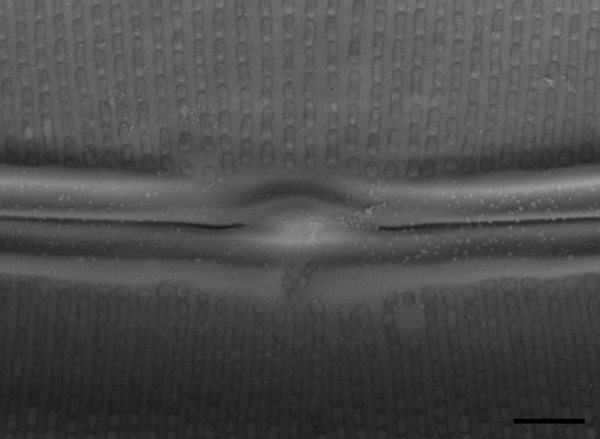Frustulia capitata
-
Category
-
Length Range26.0-43.0 µm
-
Width Range7.0-8.5 µm
-
Striae in 10 µm34-36 at the center, 35-38 at the ends
-
Reported AsFrustulia weinholdii (Patrick and Reimer 1966)
-
ContributorCarrie Graeff - Oct 2011
-
ReviewerSarah Spaulding - Jan 2012
Identification
Description
The valves are linear-lanceolate with capitate to subcapitate apices. The striae are parallel or slightly radiate at the valve center, parallel along the length of the valve, and convergent at the ends of the valve. Areolae comprising the striae are round or oval. At the central area, the striae give the central area a relatively linear appearance, though one or a few areolae can extend onto the central area. Internally, the longitudinal ribs terminate well before both the helictoglossae. The longitudinal ribs are complete only on the side of the valve to which the proximal raphe ends are deflected.
F. capitata is a species that has been separated from the broad taxon concept of F. weinholdii established by Patrick and Reimer (1966) where they described the apices of F. weinholdii as round to capitate. At least two additional species have since been separated from F. weinholdii, including those populations with relatively round or slightly rostrate apices. Under the broad concept of the taxon, reports of F. weinholdii have been numerous in the United States.
Original Description
Valves are linear or linear-lanceolate with subcapitate or sometimes slightly capitate apices. In some specimens, the protracted portion of the valve apices is bent. Striae are slightly radiate, or less commonly parallel at the valve center, parallel towards the poles, and convergent at the poles. Most areolae comprising the striae are round or oval, but elongated areolae are common, especially at the apices. The majority of the areolae at the apices are relatively small and round compared to areolae on the rest of the valve. The central area is relatively linear. Internally, areolae are occluded. The dorsal longitudinal rib is interrupted in the center and tapers before reaching the central nodule, but the ventral longitudinal rib is either continuous or interrupted by an areola. External distal raphe ends terminate in a shallow transverse depression, and the external proximal raphe ends curve unilaterally. The cingulum is comprised of an ornamented closed valvocopula and a few open girdle bands, each with at least one row of poroids. One distal end of the girdle band can be significantly wider than the majority of the girdle band.
-
AuthorGraeff and Kociolek 2011
-
Length Range26.0-43.0 µm
-
Width7.0-8.5 µm
-
Striae in 10µm34-36 at the center, 35-38 at the ends
Citations & Links
Citations
Links
Cite This Page
Graeff, C. (2011). Frustulia capitata. In Diatoms of North America. Retrieved April 19, 2024, from https://diatoms.org/species/frustulia_capitata1
Responses
The 15 response plots show an environmental variable (x axis) against the relative abundance (y axis) of Frustulia capitata from all the stream reaches where it was present. Note that the relative abundance scale is the same on each plot. Explanation of each environmental variable and units are as follows:
ELEVATION = stream reach elevation (meters)
STRAHLER = distribution plot of the Strahler Stream Order
SLOPE = stream reach gradient (degrees)
W1_HALL = an index that is a measure of streamside (riparian) human activity that ranges from 0 - 10, with a value of 0 indicating of minimal disturbance to a value of 10 indicating severe disturbance.
PHSTVL = pH measured in a sealed syringe sample (pH units)
log_COND = log concentration of specific conductivity (µS/cm)
log_PTL = log concentration of total phosphorus (µg/L)
log_NO3 = log concentration of nitrate (µeq/L)
log_DOC = log concentration of dissolved organic carbon (mg/L)
log_SIO2 = log concentration of silicon (mg/L)
log_NA = log concentration of sodium (µeq/L)
log_HCO3 = log concentration of the bicarbonate ion (µeq/L)
EMBED = percent of the stream substrate that is embedded by sand and fine sediment
log_TURBIDITY = log of turbidity, a measure of cloudiness of water, in nephelometric turbidity units (NTU).
DISTOT = an index of total human disturbance in the watershed that ranges from 1 - 100, with a value of 0 indicating of minimal disturbance to a value of 100 indicating severe disturbance.

Frustulia capitata
- Longitudinal ribs complete, or nearly complete, on one side only
- Capitate to subcapitate apices
- External proximal raphe ends unilaterally deflected
The longitudinal ribs of F. capitata are complete only on the side of the valve, the same side to which the proximal raphe ends are deflected. The valves are linear-lanceolate with capitate to subcapitate apices. The external proximal raphe ends are unilaterally deflected.
 Diatoms of North America
Diatoms of North America





